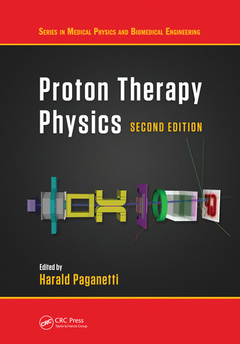Description
Proton Therapy Physics, Second Edition (2nd Ed.)
Series in Medical Physics and Biomedical Engineering Series
Coordinator: Paganetti Harald
Language: English
Subjects for Proton Therapy Physics, Second Edition:
Keywords
radiation therapy; treatment planning; radiation monitoring; radiation oncology; dose distribution; Bernard Gottschalk; Marco Schippers; Hsiao-Ming Lu; Jacob Flanz; Roelf Slopsema; Nisy Elizabeth Ipe; Hugo Palmans; Zuofeng Li; Stella Flampouri; Daniel K; Yeung; Juliane Daartz; Timothy C; Zhu; Haibo Lin; Jiajian Shen; Ben Clasie; Hanne M; Kooy; Martijn Engelsman; Lei Dong; Anthony Lomax; Jatinder R; Palta; Christoph Bert; Antje C; Knopf; Alexei V; Trofimov; David Craft; Jan Unkelbach; Jon Kruse; Proton Therapy; Katia Parodi; Dose Distributions; Peter van Luijk; Proton Beams; Magnetic beam scanning; Pencil Beams; Scattering techniques; Bragg Peak; Cancer treatments; Ion Chamber; Dose Calculation; PBS; Target Volume; Plane Parallel Ionization Chambers; Monte Carlo Codes; Pristine Peaks; Lateral Penumbra; Setup Errors; Robust Optimization; Mass Stopping Power Ratios; Proton Therapy System; Ion Chamber Arrays; Radiochromic Films; Beam Range; Stopping Power; Treatment Head; Depth Dose Profiles; Gantry Angles; NTCP
Publication date: 06-2020
· 17.8x25.4 cm · Paperback
Publication date: 11-2018
· 17.8x25.4 cm · Hardback
Description
/li>Contents
/li>Readership
/li>Biography
/li>
Expanding on the highly successful first edition, this second edition of Proton Therapy Physics has been completely restructured and updated throughout, and includes several new chapters. Suitable for both newcomers in medical physics and more seasoned specialists in radiation oncology, this book provides an in-depth overview of the physics of this radiation therapy modality, eliminating the need to dig through information scattered across medical physics literature.
After tracing the history of proton therapy, the book explores the atomic and nuclear physics background necessary for understanding proton interactions with tissue. The text then covers dosimetry, including beam delivery, shielding aspects, computer simulations, detector systems and measuring techniques for reference dosimetry. Important for daily operations, acceptance testing, commissioning, quality assurance and monitor unit calibrations are outlined. The book moves on to discussions of treatment planning for single- and multiple-field uniform doses, dose calculation concepts and algorithms, and precision and uncertainties for nonmoving and moving targets. Imaging for treatment guidance as well as treatment monitoring is outlined. Finally, the biological implications of using protons from a physics perspective are discussed.
This book is an ideal practical guide for physicians, dosimetrists, radiation therapists, and physicists who already have some experience in radiation oncology. It is also an invaluable reference for graduate students in medical physics programs, physicians in their last year of medical school or residency, and those considering a career in medical physics.
Features:
- Updated with the latest technologies and methods in the field, covering all delivery methods of proton therapy, including beam scanning and passive scattering
- Discusses clinical aspects, such as treatment planning and quality assurance
- Offers insight on the past, present, and future of proton therapy from a physics perspective
1. Proton Therapy: History and Rational 2. Physics of Proton Interactions in Matter 3. Proton Accelerators 4. Characteristics of Clinical Proton Beams 5. Beam Delivery Using Passive Scattering 6. Particle Beam Scanning 7. Secondary Radiation Production and Shielding at Proton Therapy Facilities 8. Monte Carlo Simulations 9. Detectors and Relative Dosimetry 10. Reference Dosimetry and Primary Standards 11. Acceptance Testing and Commissioninn 12. Quality Assurance 13. Monitor Unit Calibration 14. Dose Calculation Algorithms 15. Physics of Treatment Planning for Single-Field Uniform Dose 16. Physics of Treatment Planning Using Scanned Beams 17. Precision and Uncertainties in Planning and Delivery 18. Precision and uncertainties for moving targets 19. Treatment-Planning Optimization 20. Proton Image Guidance 21. In Vivo Dose Verification 22. The Physics of Proton Biology 23. Fully Exploiting the Benefits of Protons: Using Risk Models for Normal Tissue Complications in Treatment Optimization
Harald Paganetti received his PhD in nuclear physics from the Rheinische-Friedrich-Wilhelms University in Bonn, Germany in 1992. He subsequently entered the field of medical physics and later joined the physics team at Massachusetts General Hospital in 1998. He is currently the Director of Physics Research for Radiation Oncology at Massachusetts General Hospital and a Professor of Radiation Oncology at Harvard Medical School. He has authored and co-authored more than 200 peer-reviewed publications and has edited two books on Proton Therapy.
He has made significant contributions to the field of radiation oncology physics, many of which have found their way into clinical practice. Particularly, he is a pioneer in advanced Monte Carlo dose calculations for proton therapy treatment planning, which allowed the reduction of treatment planning margins for many patients, and in four-dimensional dose calculation aiming at a better understanding of motion effects when using radiation therapy for moving targets. He is considered the world expert on the relative biological effectiveness of proton beams and has had a significant impact in biological effect modeling. In 2014 he received the Excellence in Mentoring Award from Harvard Medical School recognizing his teaching and mentoring activities for junior faculty and students. He serves on various committees mainly for the American Association of Physicists in Medicine (AAPM), for which he was named Fellow in 2014, and American Society for Therapeutic Radiology and Oncology (ASTRO). He is also a member of the National Council on Radiation Protection and Measurements (NCRP).
These books may interest you

Proton and Carbon Ion Therapy 56.31 €

Proton and Carbon Ion Therapy 178.41 €


